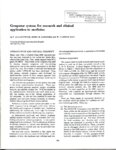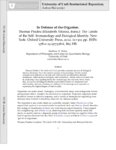Filters: Collection: "ir_uspace"
| Creator | Title | Description | Subject | Date | ||
|---|---|---|---|---|---|---|
| 201 |
 |
Pryor, T. Allan | Computer System for Research and Clinical Application to Medicine | Biomedical Informatics | 1968 | |
| 202 |
 |
Bohs, Lynn A. | Four new species of Cyphomandra (Solanaceae) from South America | Four new species in the Neotropical genus Cyphomandra are described and illustrated. Cyphomandra pilosa and C. foetida are found on the eastern slopes of the Andes from Colombia to Peru. Cyphomandra oblongifolia is a morphologically variable species of Suriname and the Amazon basin. Cyphomandra sib... | Cyphomandra | 1988 |
| 203 |
 |
Spencer S. Eccles Health Sciences Library, University of Utah | IAIMS Newsletter Fall 2002 | The IAIMS Newsletter is published three times a year (August, January, May) with one InfoFair supplement and provides valuable information about Library activities and resources as well as informative articles related to information technology. | IAIMS | 2002-08-09 |
| 204 |
 |
Miller, Jan D. | Microscopic observations of bitumen spreading at gas bubble surfaces | Bitumen spreading at gas bubble surfaces was observed through a stereoscopic microscope for Whiterocks oil sand samples submerged in alkaline solutions. This phenomenon was also observed for model systems where air bubbles were placed al the surface of bitumen-coated quartz slide. Finally, the film ... | Hydrophobic minerals; Oil sand; Gas bubbles | 1995 |
| 205 |
 |
Horch, Kenneth W. | On the number and nature of regenerating myelinated axons after lesions of cutaneous nerves in the cat | 1. Electrophysiological and anatomical techniques were used to investigate normal and regenerating sural and posterior femoral cutaneous nerve fibres in the cat. 2. One and a half years after transection of these nerves it was found that the regenerating neurones supported multiple sprouts in the... | Nerve fibres; Transection; Nerve injury | 1981 |
| 206 |
 |
Hansen, Mark S.; Coffin, Cheryl M.; Capecchi, Mario R. | Pax3:Fkhr interferes with embryonic Pax3 and Pax7 function: implications for alveolar rhabdomyosarcoma cell of origin. | To investigate the role of the translocation-associated gene Pax3:Fkhr in alveolar rhabdomyosarcomas, we generated a Cre-mediated conditional knock-in of Pax3:Fkhr into the mouse Pax3 locus. Exploring embryonic tumor cell origins, we replaced a Pax3 allele with Pax3:Fkhr throughout its expression do... | Neuroprogenitor; Embryogenesis | 2004-11-01 |
| 207 |
 |
Miller, Jan D.; Wan, Rong Yu | Significance of carbon properties in the enhanced ferric sulfate leaching of CuFeS2/C aggregates | Acid ferric sulfate solution has been used for heap and dump leaching of low-grade chalcopyrite ores and is being considered as a possible lixiviant for the hydrometallurgical processing of copper sulfide concentrates. For many years, researchers have attempted to explain the leaching behavior of ch... | Ferric sulfate; CuFeS2; Particulate carbon | 1984 |
| 208 |
 |
Olivera, Baldomero M. | Single amino acid substitutions in ĸ-conotoxin PVIIA disrupt interaction with the Shaker K+ channel | ĸ-Conotoxin PVIIA (ĸ-PVIIA), a 27-amino acid peptide with three disulfide cross-links, isolated from the venom of Conus purpurascens, is the first conopeptide shown to inhibit the Shaker K1 channel (Terlau, H., Shon, K., Grilley, M., Stocker, M., Stühmer, W., and Olivera, B. M. (1996) Nature ... | Conotoxins; k-conotoxin PVIIA; Shaker K+ channels; Conus purpurascens | 2000 |
| 209 |
 |
Olivera, Baldomero M.; Hillyard, David R.; Gray, William Robert | ĸ-Conotoxin PVIIA is a peptide inhibiting the Shaker K+ channel | ĸ-Conotoxin PVIIA (k-PVIIA), a 27-amino acid toxin from Conus purpurascens venom that inhibits the Shaker potassium channel, was chemically synthesized in a biologically active form. The disulfide connectivity of the peptide was determined. ĸ-Conotoxin PVIIA has the following structure. | Conotoxins; k-Conotoxin PVIIA; Conus purpurascens | 1998 |
| 210 |
 |
Flynn, John J. | Reaganomics and antitrust enforcement: a jurisprudential critique | There are few judges, psychoanalysts or economists today who do not begin a consideration of their typical problems with some formula designed to cause all moral problems to disappear and to produce an issue purified for the procedure of positive empirical science. But the ideals have generally reti... | Ethics; Morality; Antitrust Law | 1983 |
| 211 |
 |
Newell, Martin Edward | The utilization of procedure models in digital image synthesis | Many algorithms have been developed for synthesizing shaded images of three dimensional objects modeled by computer. In spite of widely differing approaches the current state of the art algorithms are surprisingly similar with respect to the richness of the scenes they can process. One attribute the... | Digital image synthesis; Procedure models; Shaded images; Three dimensional objects | 1976 |
| 212 |
 |
Li, Minqi | China: hyper-development and environmental crisis | China's spectacular economic growth has been one of the most dramatic developments in the global economy over the past quarter century. Between 1978 and 2004 the Chinese economy expanded at an annual rate of 9.4 per cent. No other large economy has ever grown so rapidly for so long in the economic h... | China; Economic growth; Environmental impacts | 2007 |
| 213 |
 |
Gardner, Reed M. | Fundamentals of Physiologic Monitoring | Biomedical Informatics | 1993 | |
| 214 |
 |
Beckerle, Mary C. | Identification of a new protein localized at sites of cell-substrate adhesion | A new protein found at sites of cellsubstrate adhesion has been identified by analysis of a nonimmune rabbit serum. By indirect immunofluorescence this serum stains focal contacts (adhesion plaques) and the associated termini of actin filament bundles in cultured chicken cells. | Actin; Nonimmune rabbit serum; Polypeptide | 1986 |
| 215 |
 |
Haber, Matthew | In defense of the organism: Thomas Pradeu (Elizabeth Vitanza, trans.): The limits of the self: immunology and biological identity. New York: Oxford University Press, 2012, ix+302 pp, ISBN: 978-0-19-977528-6, $65 HB. | Thomas Pradeu's The Limits of the Self provides a precise account of biological identity developed from the central concepts of immunology. Yet the central concepts most relevant to this task (self and nonself ) are themselves deemed inadequate, suffering from ambiguity and imprecision. Pradeu seeks... | 2014-01-01 | |
| 216 |
 |
Olivera, Baldomero M. | Novel Conus peptide ligand for K+ channels | Voltage-gated ion channels determine the membrane excitability of cells. Although many Conus peptides that interact with voltage-gated Na+ and Ca2+ channels have been characterized, relatively few have been identified that interact with K+ channels. We describe a novel Conus peptide that intera... | Conus peptides; Conotoxins | 2003 |
| 217 |
 |
Berg, Cynthia A. | Perspectives for viewing intellectual development throughout the life course | What has one voice and is four-footed, two-footed, and three-footed? The task of characterizing intellectual development throughout the life course can be likened to the situation that faced the Thebans as they tried to solve this riddle of the Sphinx. Oedipus gave the correct answer to this riddle... | 1992 | |
| 218 |
 |
Bhanu, Bir | Segmentation of complex outdoor scenes | A new simpler approach to image segmentation via recursive region splitting and merging is presented. Unlike other techniques the kernel of splitting is based on a generalization of a two class gradient relaxation method and merging uses a statistical analysis of variance. | Image segmentation; Outdoor scenes; Recursive region splitting; Segmentation algorithm | 1985 |
| 219 |
 |
Myers, Chris J. | Technology mapping of timed circuits | Abstract This paper presents an automated procedure for the technology mapping of timed circuits to practical gate libraries. Timed circuits are a class of asynchronous circuits that incorporate explicit timing information in the specification which is used throughout the design process to optimi... | 1995 | |
| 220 |
 |
Golden, Kenneth M. | Broad spectral, interdisciplinary investigation of the electromagnetic properties of sea ice | This paper highlights the interrelationship of research completed by a team of investigators and presented in the several individual papers comprising this Special Section on the Office of Naval Research (ONR), Arlington, VA, Sponsored Sea Ice Electromagnetics Accelerated Research Initiative (ARI). | Scattering; Radiation; EM | 1998 |
| 221 |
 |
Bastiani, Michael | Central projections of the stretch receptor neurons of crayfish: structure, variation, and postembryonic growth | Each stretch receptor neuron (SR) of the crayfish abdomen projects from its peripherally located soma an axon that enters the CNS through the second nerve (N2) of its segmental ganglion. CoZ+ backfills of N2 revealed that this axon bifurcates, sending one branch to the brain and the other to the te... | Abdomen; Axon; Ganglion | 1988 |
| 222 |
 |
Henderson, Thomas C.; Sikorski, Christopher | Computational sensor networks | We propose Computational Sensor Networks as a methodology to exploit models of physical phenomena in order to better understand the structure of the sensor network. To do so, it is necessary to relate changes in the sensed variables (e.g., temperature) to the aspect of interest in the sensor netw... | Computational sensor networks | 2007 |
| 223 |
 |
Lupton, John Mark | Control of mobility in molecular organic semiconductors by dendrimer generation | Conjugated dendrimers are of interest as novel materials for light-emitting diodes. They consist of a luminescent chromophore at the core with highly branched conjugated dendron sidegroups. In these materials, light emission occurs from the core and is independent of generation. The dendron branchin... | Dendrimer generation; Dendron branching; Charge transport; Mobility | 2001-03 |
| 224 |
 |
Gardner, Reed M. | Dynamic Response and the Essentials of Invasive Blood Pressure Monitoring | Biomedical Informatics | 1986 | |
| 225 |
 |
Olivera, Baldomero M.; Gray, William Robert | Peptide toxins from Conus geographus venom | The biochemical characterization of three highly toxic peptides from the venom of the marine snail Conus geographus is described in this report. These peptides cause their potent activity by inhibition of the postsynaptic terminus of the vertebrate neuromuscular junction. The relatively small size o... | Conus geographus; Venom; Conotoxins; Neurotoxins | 1981 |
